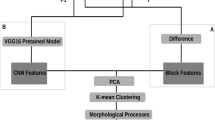Abstract
In-situ observations of solar wind plasma exhibit statistical differences according to their coronal origins. These in-situ conditions are a direct result of various processes such as ionization and acceleration occur in the inner corona. Machine learning methods have been successful in characterizing solar wind in-situ observations using unsupervised deep clustering and dimensionality reduction techniques, but it remains unclear as to how solar wind data embedding and downstream clustering could be improved while providing better interpretability in machine learning process. In this study, we explore the impact of distance metrics on solar wind in-situ data clustering. We evaluate the metric performance by applying it to dimension-reduction-stacking and deep clustering techniques and comparing it with state-of-the-art methods using solar wind in-situ measurements. Our work demonstrates the potential for customized distance metrics to improve the interpretability and performance of deep clustering approaches applied in solar wind in-situ observations.
Access this chapter
Tax calculation will be finalised at checkout
Purchases are for personal use only
Similar content being viewed by others
References
Bloch, T., Watt, C., Owens, M. et al.: Data-driven classification of coronal hole and streamer belt solar wind. Sol. Phys. 295(41) (2020) https://doi.org/10.1007/s11207-020-01609-z
Bravo, S., Stewart, G.A.: Fast and slow wind from solar coronal holes. Astrophys. J. 489, 992 (1997)
Carpenter, D., Zhao, L., Lepri, S.T., Han, H.: Characterizing in-situ solar wind observations using clustering methods. In: Han, H., Baker, E. (eds.) SDSC 2022. CCIS, vol. 1725, pp. 125–138. Springer, Cham (2022). https://doi.org/10.1007/978-3-031-23387-6_9
Cranmer, S.R.: Coronal holes and the high-speed solar wind. Space Sci. Rev. 101, 229 (2002)
Crooker, N.U., Antiochos, S.K., Zhao, X., Neugebauer, M.: Global network of slow solar wind. J. Geophys. Res. 117, A04104 (2012). https://doi.org/10.1029/2011JA017236
Garrard, T., Davis, A., Hammond, J., et al.: The ACE science center. Space Sci. Rev. 86, 649–663 (1998)
Gibson, S.E., Fan, Y.: The partial expulsion of a magnetic flux rope. Astrophys. J. 637(1), L65–L68 (2006)
Gibson, S.E., Fan, Y., Török, T., Kliem, B.: The evolving sigmoid: evidence for magnetic flux ropes in the corona before, during, and after CMEs. Space Sci. Rev. 124(1–4), 131–144 (2006)
Gloeckler, G., Cain, J., Ipavich, F.M., et al.: Investigation of the composition of solar and interstellar matter using solar wind and pickup ion measurements with SWICS and SWIMS on the ACE spacecraft. Space Sci. Rev. 86, 497 (1998)
Han, H., Wentian, L., Wang, J., Qin, G., Qin, X.: Enhance explainability of manifold learning. Neurocomputing 500, 877–895 (2022)
Ko, Y.-K., Raymond, J.C., Zurbuchen, T.H., et al.: Abundance variation at the vicinity of an active region and the coronal origin of the slow solar wind. Astrophys. J. 646, 1275 (2006)
Lepri, S.T., Zurbuchen, T.H.: Iron charge state distributions as an indicator of hot ICMEs: possible sources and temporal and spatial variations during solar maximum. J. Geophys. Res. 109, A01112 (2004). https://doi.org/10.1029/2003JA009954
Liu, S., Su, J.T.: Multi-channel observations of plasma outflows and the associated small-scale magnetic field cancellations on the edges of an active region. Astrophys. Space Sci. 351, 417 (2014)
McComas, D., Bame, S., Barker, P., et al.: Solar wind electron proton alpha monitor (SWEPAM) for the advanced composition explorer. Space Sci. Rev. 86, 563–612 (1998)
Roberts, D.A., et al.: Objectively determining states of the solar wind using machine learning. ApJ 889, 153 (2020)
Smith, C., L’Heureux, J., Ness, N., et al.: The ACE magnetic fields experiment. Space Sci. Rev. 86, 613–632 (1998)
Stakhiv, M., Landi, E., Lepri, S.T., Oran, R., Zurbuchen, T.H.: On the origin of mid-latitude fast wind: challenging the two-state solar wind paradigm. Astrophys. J. 801, 100 (2015)
Wang, Y.-M., Ko, Y.-K.: Observations of slow solar wind from equatorial coronal holes. Apj 880, 146 (2019)
Wang, Y.-M., Grappin, R., Robbrecht, E., et al.: On the nature of the solar wind from coronal pseudostreamers. Astrophys. J. 749, 182 (2012)
Wang, Y.-M., Ko, Y.-K., Grappin, R.: Slow solar wind from open regions with strong low-coronal heating. Astrophys. J. 691, 760 (2009)
Zhao, L., Landi, E., Zurbuchen, T.H., Fisk, L.A., Lepri, S.T.: The evolution of 1 AU equatorial solar wind and its association with the morphology of the heliospheric current sheet from solar cycles 23 to 24. Astrophys. J. 793, 44, 8 pp (2014). https://doi.org/10.1088/0004-637X/793/1/44
Zhao, L., Zurbuchen, T.H., Fisk, L.A.: Global distribution of the solar wind during solar cycle 23: ACE observations. Geophys. Res. Lett. 36, L14104 (2009)
Zhao, L., Gibson, S.E., Fisk, L.A.: Association of solar wind proton flux extremes with pseudostreamers. J. Geophys. Res. Space Phys. 118, 2834–2841 (2013)
Zhao, L., et al.: On the relation between the in-situ properties and the coronal sources of the solar wind. Astrophys. J. 846(2), 135 (2017)
Zhao, L., et al.: An anomalous composition in slow solar wind as a signature of magnetic reconnection in its source region. ApJS 228, 1 (2017)
Zirker, J.B.: Coronal holes and high-speed wind streams. Rev. Geophys. Space Phys. 15, 257 (1977)
Zurbuchen, T.H., Fisk, L.A., Gloeckler, G., von Steiger, R.: The solar wind composition throughout the solar cycle: a continuum of dynamic states. Geophys. Res. Lett. 29(9) (2002). https://doi.org/10.1029/2001GL013946
Han, H., Li, D., Liu, W., Zhang, H., Wang, J.: High dimensional mislabeled learning. Neurocomputing 573, 127218 (2024)
Acknowledgements
The work of D.C. is supported by NASA grant 80NSSC22K1015. L.Z. is supported by NASA Grants 80NSSC21K0579, 80NSSC22K1015, NSF SHINE grant 2229138, and NSF Early Career grant 2237435. H.H is supported by the McCollum endowed chair startup fund of Baylor University.
Author information
Authors and Affiliations
Corresponding author
Editor information
Editors and Affiliations
Rights and permissions
Copyright information
© 2024 The Author(s), under exclusive license to Springer Nature Switzerland AG
About this paper
Cite this paper
Carpenter, D.T., Han, H., Zhao, L. (2024). Dimension Reduction Stacking for Deep Solar Wind Clustering. In: Han, H., Baker, E. (eds) Next Generation Data Science. SDSC 2023. Communications in Computer and Information Science, vol 2113. Springer, Cham. https://doi.org/10.1007/978-3-031-61816-1_8
Download citation
DOI: https://doi.org/10.1007/978-3-031-61816-1_8
Published:
Publisher Name: Springer, Cham
Print ISBN: 978-3-031-61815-4
Online ISBN: 978-3-031-61816-1
eBook Packages: Computer ScienceComputer Science (R0)




